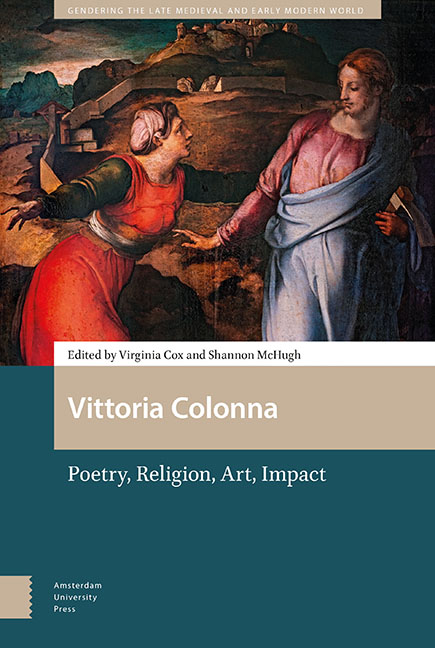Book contents
- Frontmatter
- Dedication
- Contents
- List of Illustrations
- Acknowledgements
- Introduction: The Twenty-First Century Vittoria Colonna
- Part 1 Literary and Spiritual Sociability
- Part 2 Widowhood
- Part 3 Poetry
- Part 4 Art
- Part 5 Readership
- Part 6 Impact
- Volume Bibliography
- Index of Citations of Colonna’s Letters and Verse
- Thematic Index
10 - ‘A More Loving and Constant Heart’: Vittoria Colonna, Alfonso d’Avalos, Michelangelo and the Complicated History of Pontormo’s Noli me tangere
Published online by Cambridge University Press: 16 December 2021
- Frontmatter
- Dedication
- Contents
- List of Illustrations
- Acknowledgements
- Introduction: The Twenty-First Century Vittoria Colonna
- Part 1 Literary and Spiritual Sociability
- Part 2 Widowhood
- Part 3 Poetry
- Part 4 Art
- Part 5 Readership
- Part 6 Impact
- Volume Bibliography
- Index of Citations of Colonna’s Letters and Verse
- Thematic Index
Summary
Abstract
Designed by Michelangelo, painted by Pontormo, and reproduced by other masters, the Noli me tangere (c. 1531–32) and its subsequent copies were the product of a chain of mediations on the part of painters, patrons and their proxies. The original recipient of the intensely dramatic composition, commissioned through an intermediary, was Vittoria Colonna. At the heart of this study is a discussion of the emotionally engaging—and profoundly unorthodox—ways in which Michelangelo and Pontormo envisage the tension of the moment of witness between the risen Christ and the Magdalene. The chapter also examines Colonna's own spiritual and poetic relationship with the figure of Mary Magdalene, and that of other women in her circle.
Keywords: Colonna, Michelangelo, Pontormo, Mary Magdalene, Noli me tangere, cartoon/cartone, patronage
Entwined destinies
The following story is of no ordinary artistic commission. It may best be described as a chain reaction, set in motion by an exceptional woman and involving a large cast of characters. A number of contributions to the present volume eloquently frame Vittoria Colonna as progenitor and exemplar, at once spiritual and literary. In this essay, I would like to introduce a devotional model of her own: Colonna's most inspiring source of emulation (matched only by Catherine of Alexandria and the Virgin Mary herself)—Mary Magdalene. The story also features a cohort of male protagonists of crossed destinies: patrons, painters and a string of intermediaries, brokers and agents facilitating the commission; their various relationships to the Marchioness of Pescara, direct or indirect, serving as the ligatures that bind them. United in partnership within this group is another pairing: that of Michelangelo and Jacopo da Pontormo, two artists joined in collaboration twice within a year, at one point even working under one roof. Along the way, I hope we might rediscover a new complexity and nuance in commonly used terms like ‘patronage’ and ‘authorship’, as the role of mediators in the first case and copies in the second are key to understanding artistic production and notions of value in this period.
Vittoria Colonna was recognized in her lifetime as a poetic innovator, a catalyst of Catholic reform and as a paragon of piety (Fig. 10.1).
- Type
- Chapter
- Information
- Vittoria ColonnaPoetry, Religion, Art, Impact, pp. 229 - 270Publisher: Amsterdam University PressPrint publication year: 2021



